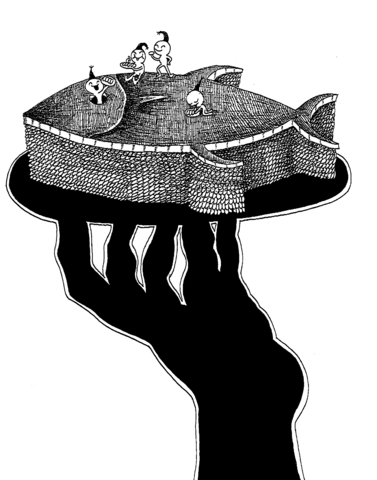In the dark green waters off the coast of western Japan, scores of 68kg bluefin tuna glided counterclockwise inside a pen 46m in diameter, the telltale blue streaks on their bodies shimmering just below the surface.
The fish, though, were not just any kind of bluefin tuna, whose fatty flesh is the most prized delicacy at exclusive sushi restaurants in Japan and has set off fishing wars in the world's oceans. They represented the holy grail of fish breeding: bluefin tuna born and raised in captivity.
They were also the lifework of the man shoveling mackerel into the pen from the edge of a boat one recent afternoon, Hidemi Kumai, 71, the head of Kinki University's Fisheries Laboratory. Kumai had spent more than three decades trying to farm the bluefin tuna -- an unusually delicate fish, both physically and psychologically, prone to everything from restlessness to cannibalism -- before succeeding in 2002. Two years later, he began sending it off to sushi counters in Osaka and Tokyo.

"I felt as if I were giving away my daughters in marriage," Kumai said.
When he undertook his quest in 1970, tuna were plentiful in Japanese waters and the Japanese were really the only people interested in eating slices of raw fish. Today, even as the popularity of sushi keeps increasing worldwide, overfishing and pollution have pushed down edible fish stocks.
The competition has become fiercest over the bluefin tuna, which fetches about US$110 a pound at the Tsukiji fish market in Tokyo, the world's biggest. Of the five kinds of tuna eaten in Japan, bluefin accounts for less than 2 percent. But fishermen from New Zealand to Libya comb seas for it; in Croatia, Spain and elsewhere, young bluefin tuna are caught and fattened inside giant underwater cages before being shipped to Japan.
Despite international quotas, the appetite for bluefin tuna is so insatiable that in the Mediterranean it is on the verge of extinction, according to the World Wildlife Fund. To curb quota violations and what the industry calls tuna laundering, Japanese officials have started carrying out DNA tests on imported bluefin tuna.
The Japanese, who eat about 80 percent of the world's bluefin tuna, are now contending with competition from, predictably, the Chinese. As Chinese in Beijing and Shanghai become sushi devotees, they are paying top dollar for bluefin. Some of the best sushi restaurants in Japan are grumbling that bluefin has become too expensive and hard to buy -- and that they might scratch tuna from their menus instead of suffering the indignity of serving the cheap stuff.
There is a "high possibility," Kumai said, that in a decade or two, as China keeps getting richer, Japan may simply be priced out of a shrinking bluefin market.
"Now only Chinese in the coastal areas are eating sushi or can afford to," Kumai said. "What happens when the Chinese in the vast hinterland start eating sushi?"
As part of Japan's national interest, and also because the Japanese have been exhausting the world's tuna stocks, Kumai advocated the large-scale farming of bluefin tuna, led by the government.
"This has to be a national project," he said. "Now Americans and Chinese are eating sushi, so we can't just sit back."
The outside threat has added urgency to Kumai's work, one that he had never imagined when he began fish farming in the late 1950s. As a boy growing up in the landlocked prefecture of Nagano, he had longed to see the ocean, but World War II restricted travel. When he finally caught a glimpse of the sea during a junior high school trip, he was hooked.
Over the years, the university's Fisheries Laboratory was first in the captive breeding of about 20 fish species, including halibut, flat bream and Japanese amberjack. Much of the work went on in the placid Pacific waters between the town of Kushimoto and the small island of Oshima, where various fish are farmed inside pens.
But bluefin are the main attraction. At first, capturing young bluefin in the wild and transporting them into pens proved difficult, with most of them dying in fishermen's nets. Bluefin bruise easily because of their delicate scales, and their gills take in little oxygen compared to other fish, so they have to swim continuously to breathe -- even while asleep.
Cooped up, many died quickly. Eventually, Kumai learned how to keep them alive and scored a first in 1979 when the fish spawned inside a pen. Still, after hatching, the fry died after a few weeks -- a cycle that went on until 1982, when the fish inexplicably stopped spawning.
They resumed in 1994, but new problems arose. The fry survived, but the bigger ones kept gobbling up their little brethren.
"Other fish, the sea bream or flatfish, do that, too," Kumai said. "But tuna are very aggressive. The population could shrink to a third overnight."
Kumai scooped the fry into bowls -- their delicate bodies would chafe at nets -- and segregated them by size. Unlike other species, they quickly grew tails but lagged behind in developing other fins -- so that they could advance but not turn.
"They kept crashing into nets and dying," Kumai said with a grave face. "We took X-rays and found their necks were broken."
For fish that can grow to be as large as 800kg, they are also unusually sensitive. Fireworks, even the headlight of a car, can cause them to panic, crash into nets and break their necks.
Nevertheless, many survived and spawned eggs. In 2002, these eggs hatched and the fry survived. By segregating the fry from the larger fish, raising them in bigger pens and adjusting the water temperature and their diet through trial-and-error experiments over the years, he was able to raise them to adulthood. In 2004, these fully farmed bluefin tuna were sold to an expectant nation.
"I've never met anyone who told me it tastes bad, though I know it's hard to say that to my face," said Kumai, who said he had never eaten wild bluefin.
Some sushi chefs in Kushimoto sniff at the ranched bluefin, saying it yields a fatty meat that does not taste as good as the wild variety. Wild bluefin, migrating across oceans, tend to be lean. But Kumai's couch potatoes are 10 percent lean and 90 percent fatty.
Because of decreasing stocks, Kumai's bluefin is now sold only once a month at a Mitsukoshi department store in Tokyo -- for a third less than the wild kind. That fact annoyed Kumai.
"Just because it's farmed, the prices are automatically lower," he said. "If it's good, it's good. There shouldn't be a difference."
Recently, China launched another diplomatic offensive against Taiwan, improperly linking its “one China principle” with UN General Assembly Resolution 2758 to constrain Taiwan’s diplomatic space. After Taiwan’s presidential election on Jan. 13, China persuaded Nauru to sever diplomatic ties with Taiwan. Nauru cited Resolution 2758 in its declaration of the diplomatic break. Subsequently, during the WHO Executive Board meeting that month, Beijing rallied countries including Venezuela, Zimbabwe, Belarus, Egypt, Nicaragua, Sri Lanka, Laos, Russia, Syria and Pakistan to reiterate the “one China principle” in their statements, and assert that “Resolution 2758 has settled the status of Taiwan” to hinder Taiwan’s
Singaporean Prime Minister Lee Hsien Loong’s (李顯龍) decision to step down after 19 years and hand power to his deputy, Lawrence Wong (黃循財), on May 15 was expected — though, perhaps, not so soon. Most political analysts had been eyeing an end-of-year handover, to ensure more time for Wong to study and shadow the role, ahead of general elections that must be called by November next year. Wong — who is currently both deputy prime minister and minister of finance — would need a combination of fresh ideas, wisdom and experience as he writes the nation’s next chapter. The world that
The past few months have seen tremendous strides in India’s journey to develop a vibrant semiconductor and electronics ecosystem. The nation’s established prowess in information technology (IT) has earned it much-needed revenue and prestige across the globe. Now, through the convergence of engineering talent, supportive government policies, an expanding market and technologically adaptive entrepreneurship, India is striving to become part of global electronics and semiconductor supply chains. Indian Prime Minister Narendra Modi’s Vision of “Make in India” and “Design in India” has been the guiding force behind the government’s incentive schemes that span skilling, design, fabrication, assembly, testing and packaging, and

Can US dialogue and cooperation with the communist dictatorship in Beijing help avert a Taiwan Strait crisis? Or is US President Joe Biden playing into Chinese President Xi Jinping’s (習近平) hands? With America preoccupied with the wars in Europe and the Middle East, Biden is seeking better relations with Xi’s regime. The goal is to responsibly manage US-China competition and prevent unintended conflict, thereby hoping to create greater space for the two countries to work together in areas where their interests align. The existing wars have already stretched US military resources thin, and the last thing Biden wants is yet another war.